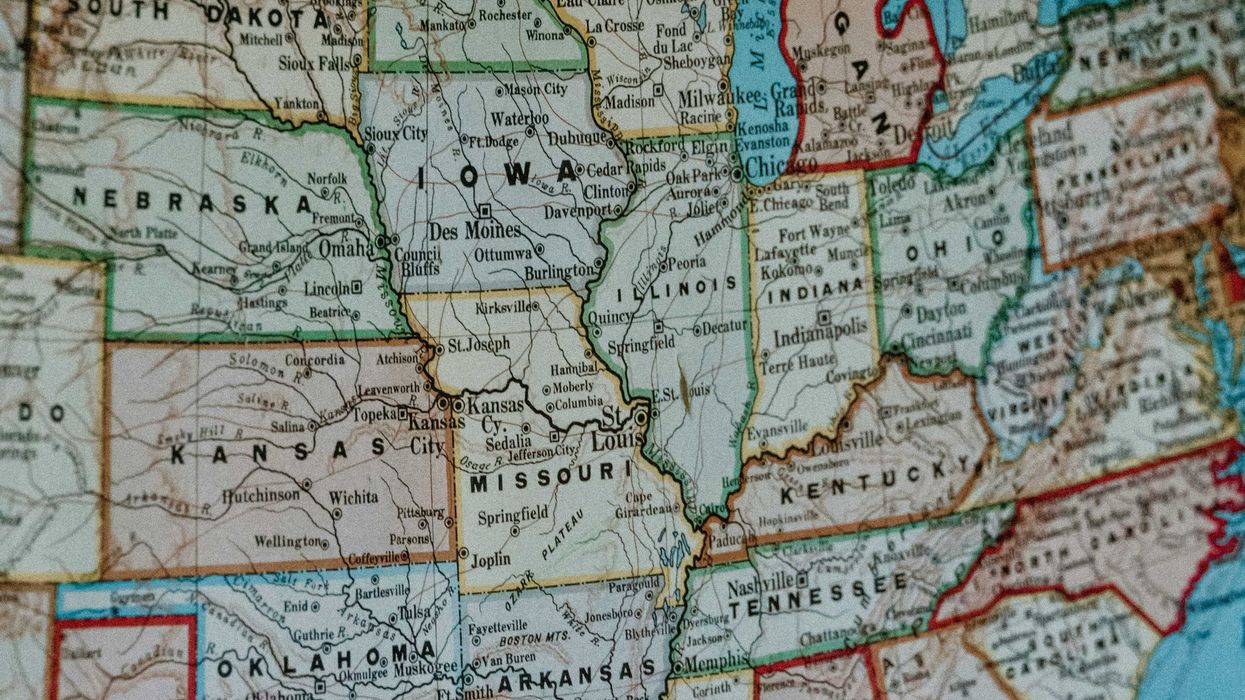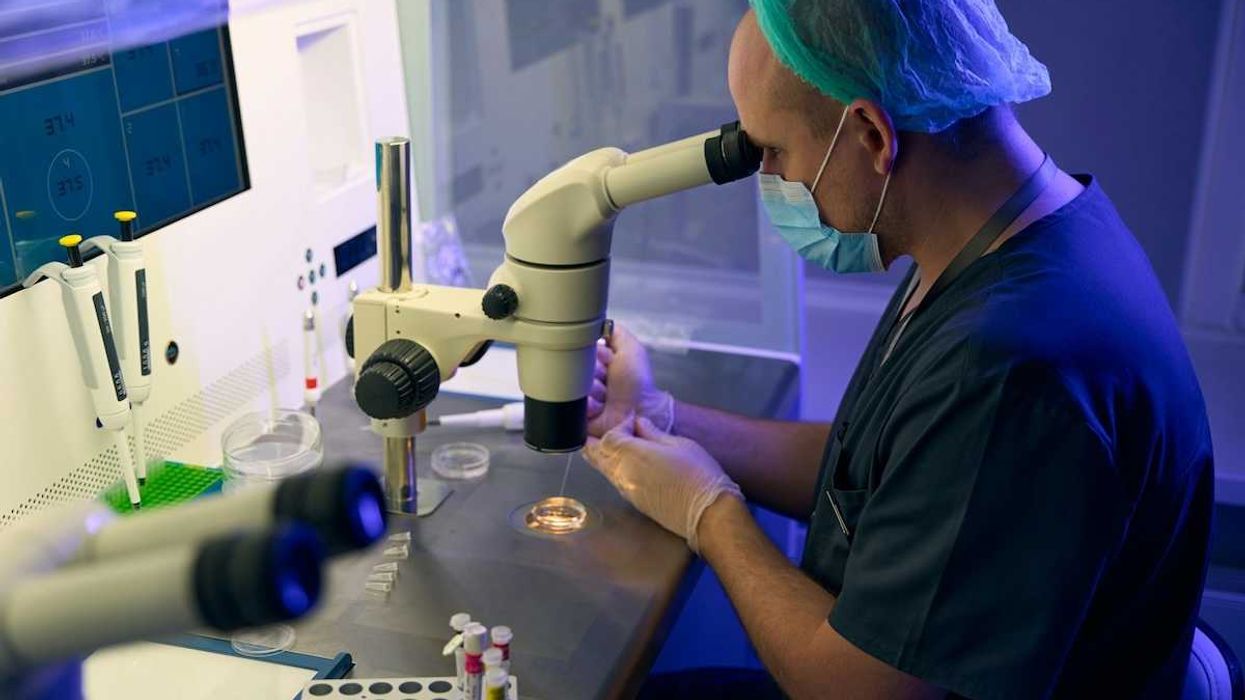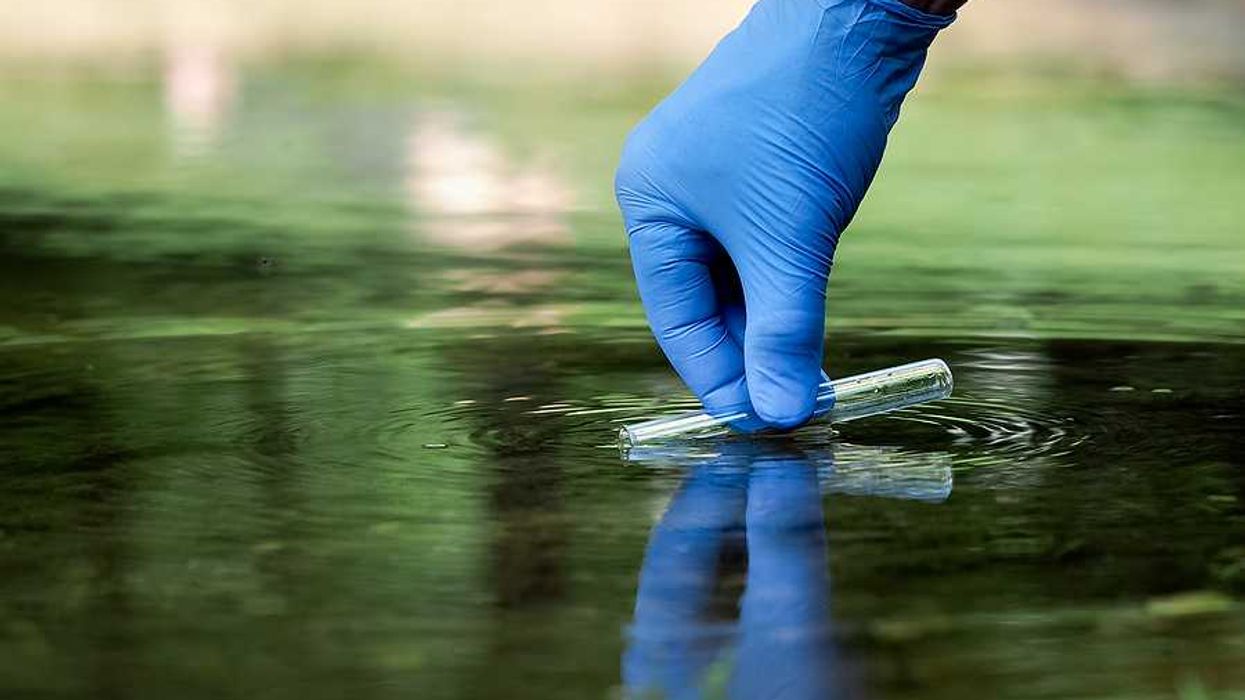PITT MEADOWS, British Columbia – On an early spring morning the Pitt River flows so calmly that the peaks of the Coast Range seem to pause to admire themselves in its glassy waters. A motorboat lifts a wake, and the docks of the marina moan. Still tucked in for the winter, the pleasure boats stir then rock themselves back to sleep.
Standing on the riverfront dike, Sandi Lee quickly locates a soon-to-be mom. "There's a nest in the scope," says Lee, offering a look.
John Elliott peers into the scope. "What stage are we at?" he asks. "Still sitting on eggs," she answers.
In her journal Lee notes who's home: Brown cap. Fierce yellow eyes. Dark necklace on a white breast. Bigger than its companion. A female osprey.
Elliott and Lee are spending a few hours on this river about 25 miles east of Vancouver counting the ospreys that have returned to lay their eggs. It's unglamorous but crucial legwork for the two scientists from Environment Canada.

Ospreys tell a story, and Elliott, Lee and the other scientists who track them are trying to decipher their messages. For more than two decades in North America, particularly in the Pacific Northwest, the osprey has revealed disturbing tales about DDT, PCBs, pulp mill dioxins, flame retardants, stain-resistant compounds, urban runoff, mining wastes, prescription drugs, mercury and more. They are living repositories for chemicals: Perched at the top, they ingest all of the contaminants in every creature below them in their food web. Some build up in their tissues, affecting their offspring. As one chemical is banned, another takes its place in the environment. How do we know this? The osprey warns us.
These raptors live all over the world, up and down the coasts of every continent. "Just add water; you'll get ospreys," said Erick Greene, a University of Montana biology professor who studies them. Also called sea hawks, ospreys are almost exclusively fishermen, elegantly adapted to their occupation. With talons like fish hooks, they can dive from 200 feet up, hitting the water at 40 miles an hour. They are the only raptor that will completely submerge in pursuit of prey.
The osprey wears a black bandit mask around its fierce yellow eyes – most likely a smart evolutionary trick to counteract the water's glare. Yet they are a remarkably mellow bird of prey – so focused on fishing that other birds make a home in the underside of their nests, and rodents seek shelter from hawks and eagles by living at the base of their snags.
They also tolerate humans well, and this ease among disturbance has made them willing to inhabit some of the more polluted waters in North America, including the Columbia River and Chesapeake Bay. It also makes them easy to study. "On I-84 going through the Columbia Gorge, there's nests within 50 feet of the highway where there is traffic going by at 70 miles an hour," said Chuck Henny, a research zoologist emeritus with the U.S. Geological Survey in Corvallis, Ore. (In Maryland, one pair turned a traffic camera into a wildlife cam when they repeatedly built a nest in front of it; they were finally given a comfortable nest box just out of the way, and now the camera pans to the birds in off-rush- hour times.)
The ultimate locavores, ospreys offer a precise gauge of contaminants released nearby and chemicals that hitchhike to their habitat from thousands of miles away via winds and currents. While they do migrate, they return to the same place to lay their eggs, sometimes even to the same nest. As a result, their eggs and chicks offer Polaroids of pollution – snapshots of what's going on in any given place at any given moment. "The species was one of the first studied on a large scale to bring contaminant issues into focus," Henny wrote.
A short-lived victory?
The fact that we're seeing ospreys at all is a victory: The pesticide DDT nearly wiped them out in the three decades after World War II. Since then, new threats have emerged and old threats linger. Chemicals pollute the natural world from manufacturing, pesticides and everyday household items like furniture, plastics, cleaners and pharmaceuticals. For many of these compounds the long-term impact on wildlife and humans remains a question mark. In higher doses some – first DDT, then mercury, then flame retardants – have impaired the ability of birds to reproduce. Some may alter their ability to migrate. Studies of other wildlife have found that contamination can interfere with everything from hatching of eggs to the livers of embryos.

An osprey hunkered in its nest can help answer not only how much pollution is out there but how much it matters – for the osprey and for us. By the 1950s the raptor was one of our first indicators of damage from DDT, which thinned birds' eggshells, killing their embryos. Their populations, along with eagles and other birds of prey, plummeted nationwide: In New England, 90 percent of ospreys vanished between 1950 and 1975, wrote David Gessner in his book Return of the Osprey.
As a boy on a farm in Oregon, Henny, 71, remembers dusting his family's crops with DDT. "I didn't have a clue," Henny said of the poison he was spreading. Today Henny, now retired, is one of the deans of osprey research in North America; he has spent a career studying contaminants in birds and mammals.
Such testing has shown that DDT's legacy persisted for decades: Some 25 years after it was banned in the United States, Henny in 1998 found some eggs from osprey nesting along the lower Columbia River contained the highest DDT concentrations of any North America osprey at the time, thanks to high amounts found in a fish they eat, the large-scale sucker. It's the consequence of both predator and prey living downstream of hundreds of miles of farm fields and orchards. In most places, osprey populations had already bounced back, but the ones near the mouth of the Columbia still felt DDT's effects until around 2001, when that population finally seemed to recover, too, Henny said.
Today at least 19,000 pairs are estimated to roost around the United States. "Because of the increasing use of artificial nesting structures, there may be more ospreys nesting in North America now than ever before," Henny and his coauthors wrote in a 2010 report.
Ospreys also have recovered in Europe, after more than a century of persecution and accidental poisoning. During the 19th and early 20th centuries they were shot or harvested – extirpated from Scotland, where their eggs were collected, according to the Global Raptor Information Network. Now there may be 11,000 breeding pairs in Europe, BirdLife International estimated.
It's mostly in the United States, though, where scientists are decoding the osprey's message about the health of the planet.
Mercury levels 'through the roof'
Around Missoula, Mont., Greene has been using osprey to help gauge the success of a massive Superfund cleanup on the Clark Fork River. Crews had scooped out decades of toxic sludge that had accumulated from a gargantuan copper mine upstream, and Greene wanted to know how well the cleanup had worked.
He turned to osprey, which nest so much along the Clark Fork that the local minor league baseball team is named for them.
The cleanup was a success: Tests of osprey eggs downstream of the dam site found quite low levels of the "big five" – arsenic, copper, zinc, cadmium and lead – targeted by the cleanup.
Then the surprise: Mercury levels in the eggs were through the roof.

Osprey chicks in Missoula had 300 micrograms of mercury per liter of blood. For humans, the guideline is 5.8 micrograms per liter for pregnant women to avoid harmful effects on unborn children. "If you or I walked into the ER in a hospital and tested out with the level that these osprey chicks have in their blood, it would be Code Red. The doctors would be freaking out," Greene said. "Above that [guideline] in humans, people have documented what's been euphemistically called 'cognitive dysfunction,' which basically means you get stupid." In studies of many human populations, mothers' consumption of high-mercury seafood has been linked to reduced IQs of their offspring.
Does this mean the osprey chicks are stupid? That's an important question but no one knows, Greene said. Young ospreys have to learn how to hunt on their own. Furthermore, they have to be able to pull off the long and complicated road trip called migration. Soon, Greene hopes to put satellite transmitters on ospreys in high- and low-mercury areas to track them and gauge any differences.
Elsewhere, researchers have documented that mercury can kill bird embryos, with varying sensitivity of species. Ospreys are among the most sensitive, according to Environment Canada researcher Birgit Braune.
In Montana, soon-to-be-published research by Greene and his colleagues has found "about 50 percent reduction in hatching success in high mercury areas," which likely resulted from old placer mining in the region. "There are very clear implications for human health," Greene said. The finding can help steer future state advisories about fish consumption.
The research also has particular relevance now as Montana considers shipping huge amounts of its coal to China. "The number one source of new mercury into the global ecosystem is from burning coal to generate electricity," he said. That Montana coal would take two months to get to China and about one week for its emissions to drift back over to Montana on the jet stream, he said.
It's a sad irony, Greene said, that we worry about mercury at home, only to make a decision that sends more mercury our way.
Good news/bad news
Back on the Pitt River, Elliott, a research scientist, and Lee, an ecotoxicology technician, walk up the dike, their eyes peeled for nests. The Pitt, before it joins the Columbia, is relatively clean and rural, its water issuing from a big mountain lake – an ideal place for ospreys to lay their eggs and raise their young. They nest here each spring before flying south each winter. Every five years the scientists collect some of the eggs to test for contaminants.

Using ospreys as monitors started here in the early 1990s with another concern. Researchers were worried that pulp mills were poisoning the Fraser, Thompson and Columbia rivers with dioxins and furans, which are carcinogenic byproducts created when bleaching pulp with chlorine. For all their beauty, the Fraser and Columbia – the great rivers of the Northwest – are a long-time dumping ground for industry, orchards, row crops, smelters and paper mills.
Detective work that began with the discovery of a collapsed heron rookery soon spread to monitoring of other birds, including osprey nests both upstream and downstream of the pulp mills. Research by Elliott and others found that embryos of osprey and other birds collected near the mill sites had high concentrations of the contaminants. At the time, they didn't appear to affect either osprey hatching success or fledgling of young. But a later study by another researcher found lower growth rates of nesting ospreys at a contaminated site when compared with an uncontaminated one. And Elliott also speculated that dioxins from pulp mills harmed the brains of male birds, altering their behaviors during mating.
These findings, among others, helped change laws: In 1992 British Columbia required industry-wide changes in the bleaching process to minimize formation of dioxins. The osprey work "contributed to the broader story that pulp mills were contributing dioxins," Elliott said. Afterward, concentrations of those chemicals and related ones plummeted in osprey eggs and fish downstream of the mills.

A newer concern is PBDEs, or polybrominated diphenyl ethers, flame retardants that have been used worldwide in household items such as sofa cushions and electronics. There is worry that PBDEs, which had been accumulating in human breast milk, cause developmental problems in fetuses. As a result they've been banned in the United States and Europe. Before the 2004 U.S. phaseout, PBDEs had been on the rise in the Columbia River system. One study had found a 12-fold increase in mountain whitefish, a favorite osprey food, between 1992 and 2000. To get some answers Henny and his colleagues turned again to the raptors.
The result was classic good news/bad news.
The bad news: PDBEs were everywhere. The scientists found them in all 120 osprey eggs tested from the Columbia, Willamette and Yakima rivers as well as Puget Sound from 2002 to 2007. Similar results were found in Sweden, Norway, British Columbia and elsewhere in the United States.

The good news: Concentrations of the flame retardants in osprey eggs seemed to crest between 2005 and 2007 and then decreased, likely in response to the phaseout.
Relatively little is known about the effects of PBDEs on osprey and other wildlife, but research in lab animals suggests that high levels impair thyroid hormones, which are critical for brain development. Also, a handful of eggs from both the Willamette River and the lower Columbia were found with PBDE concentrations higher than 1 part per million, which seemed to reduce the number of fledglings they produced per nest. "When the eggs got above about 1 part per million of these PDBEs, there was suggestion of a reproductive effect," Henny said. Along the Pitt River, ospreys had been reproducing rather well but "nest success wasn't so good here" in recent years, Elliott said. He's not sure why, since "the [general] contaminant load was not that high here."
For several years scientists who have been working to keep the Columbia River clean have worried about an array of new pollutants. More than 100 chemicals from everyday life were recently found in the street runoff and treated sewage that is discharged into the river system. USGS scientists and colleagues have found dozens of contaminants accumulating in the river's sediment – compounds they thought would have vanished in the Columbia's massive flow. Included were traces of endocrine-disrupting compounds, or contaminants that mimic or block hormones. Are these pollutants having an effect? The researchers decided to examine the whole food web – topped by the osprey.
Key to their investigation were "prey baskets" – picture a garbage can that hangs around a nest, into which the osprey drop scraps. Scientists examine the contents to study large-scale suckers,
a fish that is the ospreys' main diet in the lower Columbia. The results, published earlier this year, showed concentrations of many of the contaminants – flame retardants, pesticides, PCBs – increased in osprey eggs, as well as the sediment and fish, as one moved downstream toward Portland. In short, the more industrial and crowded the location, the more contaminated the sediment. Moreover, several contaminants in fish fillets exceeded the levels in state guidelines. This will be used by Washington and Oregon health officials to advise the public about how much fish is safe to eat.
USGS research chemist Elena Nilsen credits the messy garbage cans for stimulating researchers to investigate these new questions. "We knew that the concentrations were going up in the eggs, and you assume that it's coming through the diet, but no one had really studied it," she said.
People today, Nilsen said, are adding hundreds of contaminants to the environment, from cleaners to soaps to coatings, yet we don't understand the effects on wildlife – or on ourselves.
Telling tales of new threats
After counting osprey at the marina, Elliott and Lee drive a few miles upstream, to Addington Marsh, a wildlife area on Pitt Lake, the largest lake in the greater Vancouver area. It's an osprey bonanza: A stick nest as big as a wagon wheel sits on a piling every 200 yards or so, each with a female. Sometimes an expectant father hovers, looking useless. As they walk Lee makes notes in her journal, and Elliott switches from quiet to passionate. Over the years he has watched as pollutants in osprey have changed: first DDT, then PCBs, then PBDEs.
The only constant is that they keep coming.
More recently Elliott has been studying the role of perfluorinated compounds – chemicals used widely to make products stain- resistant, and used to manufacture everything from non-stick cookware to firefighting foam. While these compounds aren't stored in fat like DDT, the amount of time it can take for them to leave the body can be years. In animal studies some of these compounds disrupt normal hormones, suppress immune function and cause developmental problems in rodent fetuses, according to the National Institute of Environmental Health Sciences.

One of these compounds that has particularly worried Elliott and others is perfluorooctane sulfonate, or PFOS, which was used in Scotchgard until it was phased out by 3M in 2002. Five years later, in a study along Maine's coasts and waterways, PFOS concentrations in three-quarters of osprey eggs exceeded a threshold for health effects in chickens. A Flag Island egg had the highest PFOS level detected in Maine wildlife, and at the time of the
study it was one of the higher levels detected in any eggs, said study author Wing Goodale, deputy director of the Biodiversity Research Institute. PFOS is a global issue: Osprey eggs from Chesapeake Bay and Delaware Bay contained similar amounts to eggs of other water birds in Japan and Norway.
What does this mean for the osprey? "For some of the newly emerging contaminants, a lot of those questions are still up in the air," said Chris DeSorbo, raptor program director at the Biodiversity Research Institute.
For perfluorinated compounds, little is known about how much birds can handle, although rodent experiments suggest they damage the liver and reduce the viability of embryos. And there is already evidence that this isn't just a concern for birds: Elevated levels of perfluorinated chemicals, including PFOS, are associated with human kidney disease, lower testosterone and other health effects.
Similar chemicals keep coming. In Elliott's longterm studies involving three species of seabirds from the northeast Pacific, a contaminant related to PFOS has increased steadily in all the birds studied, no matter whether they lived near the shore or at sea.
And just this month, ospreys sent warnings about another newly emerging contaminant: traces of prescription drugs emitted into bays and rivers in sewage discharge. A hypertension medication, for instance, was detected in all 69 osprey that were tested at Chesapeake Bay. For several medications, the scientists calculated that the bay's osprey would exceed human therapeutic doses in just three to seven days of eating fish. Again, the effects on osprey, or any wildlife, are unknown.
Elliott finds it all a bit exasperating.

"With all of these organic pollutants, every time you think it's just a matter of ushering this stuff out the door, letting it break down... something new comes along," he says as he ends the day's work counting osprey and walks toward the parking lot. It's hard to keep track of all the new compounds introduced into the environment, much less figure out their impacts, and it's challenging to keep the research going year after year.
But keeping tabs on these osprey is important for their own health as well as human health, Elliott says. Tracking them, he says, is "almost like a time machine." We can tell not only where we've been but where we're headed, and with luck, he says, change course in time.
Part two of Winged Warnings, published in conjunction with nationalgeographic.com. Check out the rest of the series here.
















